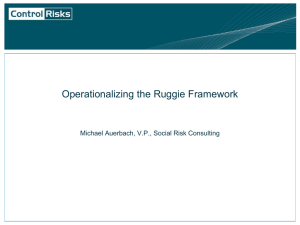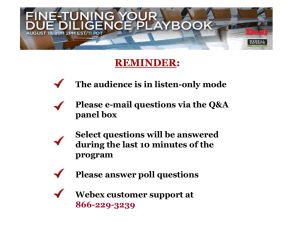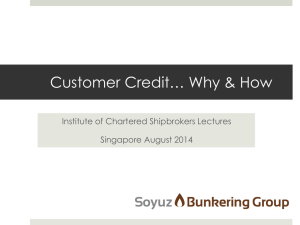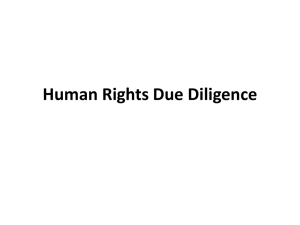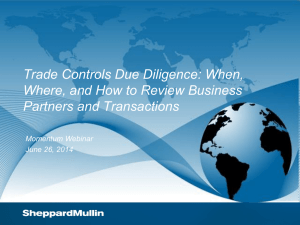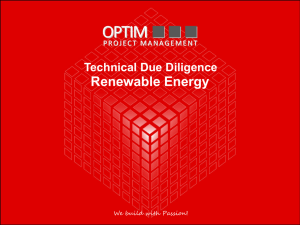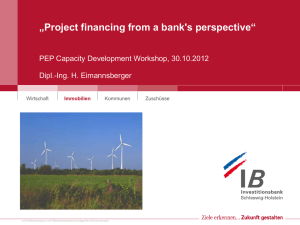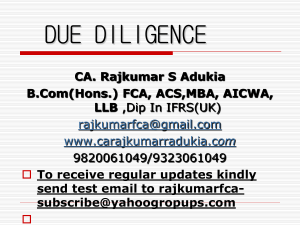Due Diligence in Merger and Acquisition
advertisement
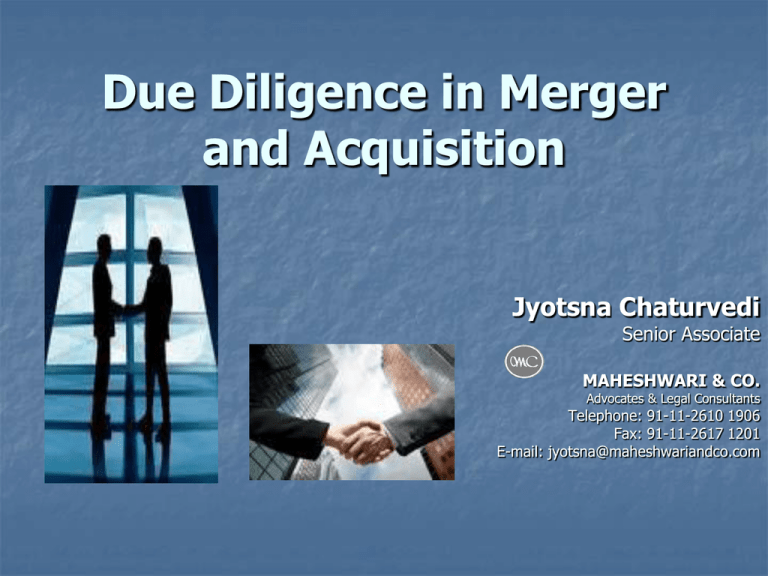
Due Diligence in Merger and Acquisition Jyotsna Chaturvedi Senior Associate MAHESHWARI & CO. Advocates & Legal Consultants Telephone: 91-11-2610 1906 Fax: 91-11-2617 1201 E-mail: jyotsna@maheshwariandco.com Due Diligence in context of M & A Due Diligence can be defined as the examination of a potential target focusing on material future matters for aiming to make an acquisition decision via the principles of valuation and shareholder value analysis and getting answers to key questions, including: Do we buy ? How much do we pay? How do we structure the acquisition Need for Due Diligence The standard puts the onus on the buyer to conduct a thorough investigation to ensure he is receiving the benefit of the bargain. due diligence satisfies the officers' and directors' fiduciary duty to make sure any decision made will maximize value for existing shareholders. A due diligence audit is the equivalent of checking references before hiring. In general, a due diligence audit focuses on information outside of what is freely presented. Advantages of Due Diligence Maximise Synergy Develop Additional Negotiating Leverage Identify, Access and reduces risk Improve/validate valuation process Diligence is about Suggesting Solutions Identifying issues Obtaining Information Analyzing Information Reasons of Failures Contd. All these could be avoided by conducting proper due diligence what we also call 360-Degree Due Diligence (360 3D). It is a process with a comprehensive approach that engages all the relevant disciplines in order to address all the key issues that are embedded in the target to be acquired. 360 3D Financial/ Accounting Tax Legal Due Diligence Risk Management Operational Human Capital Technical Steps of Due Diligence Compiling of Due Diligence Checklist Procuring Detailed Information/Documents as per the checklist Analyzing of Information/Documents Critically evaluating the analyzed information Preparing of a Report with suggestive actions Compiling of Due Diligence Checklist Compiling a due diligence checklist is a resourceful tool when undergoing a merger and acquisition. The checklist assists in covering all business components to ensure that a proper investigation is performed in order to prevent any delays or complications for the involved parties. Categories Due Diligence Stock Exchange Compliances Property/ Leases Compliances Litigation & Claims Environment Insurance Corporate Compliances Labour / HR Compliances IPR Financial & Taxation Agreements/ Arrangements Corporate Compliances Complete Group Structure and inter group transactions Nature of Business of all with their status i.e. dormant or active Last three years financials of all as submitted to ROC, SEBI and SE Statutory Registers and Minutes Books List of all loans (inter-corporate or otherwise), agreed limits, current outstanding and copies of all agreements and other governing documents and Government/RBI approvals, as applicable. Corporate Contd. Particulars of any debentures, debenture stock, term loans or other financing arrangements and copies of all agreements and other governing documents. Copies of all outstanding mortgages, charges, liens or similar arrangements, affecting the company or any of its assets, position of registration of charges with ROC Property/Leases Title verification of purchased and leased properties. Land use/ sanctioned plan compliances. Utilities (electricity/water) compliances. Examination of leases to ensure Company’s interests is adequately protected with no hidden potential liabilities. Proper stamping and registration of property documents Municipal taxes and local tax compliances Litigation, Investigation & Claims Review of all investigations, legal action, disciplinary proceedings (including pending or threatened) against the Company and its Directors since its incorporation, by governmental or other bodies or individuals or organizations. Review of any order, judgment or decree of any Court, governmental or regulatory body to which the Company is associated or by which it is bound. Review of dispute/proceedings, if any, pending before any quasi-judicial authorities. Litigation Contd. Review of any current litigation/arbitration or other disputes in which the Company is presently involved or may become involved or any settlements entered into with respect to any litigation. Intellectual Property Rights Review of all copyrights, trademarks, service marks, patents and other intellectual property (including all applications thereof) owned/licensed/assigned/registered and copies of all agreements and instruments relating to/involving the acquisitions, assignment, licensing, ownership and registration thereof. Review of all non-disclosure agreements and/or confidentiality agreements executed by the Company. Labour/HR Compliances Business activities, office locations & hours of work for each office of the Company. Details regarding outsourcing/contract labour: Do the contractors / outsourcing agency pay wages, control and supervise their employees, grant leave, do performance appraisal, take disciplinary action and otherwise perform all the functions of an employer qua their employees? Whether the Company is exempted from complying with any Labour Legislations. HR Contd. Details of registration of the Company with various statutory authorities (if applicable) for e.g. ESI, PF, and Miscellaneous Provisions Act, Industrial Employment Standing Order’s Act, Shops & Establishment Act , Factories Act . How is Provident Fund being paid to the employees employed by the Company? Details of company’s contribution to Employees Provident Fund along with the rates and proof of upto date payment. Details of Bonus etc. if any of the Company. Environment Licences, permissions, authorizations and consents from environmental authorities Details of any breach of any law, code Details of any environmental management committee reports (if any) Hazardous materials, spills, emissions etc. of the Company CCI in M & A All M & A with combined turnover of Rs 4,500 crore or more will require approval of CCI from June 1, with an objective to safeguard interests of consumers and promote industrial growth Some major Failures Survey conducted by McKinsey and company shows that many parent companies often over estimate the value of target company due to lack of due diligence. In 1998 the German auto car maker Damlier Benz merged with Chrysler Group for a value of $36 billion. It was perceived to be a merger between equal but after a few years, the value of Chrysler fell to a mere $7.4 billion and the merger had proved to be a failure The failure was attributed to inability to conduct due diligence It over estimated the value of the target company which led to the merger being unsuccessful. How due diligence saved a company from big fraud A small Canadian exploration firm, Bre-X Minerals Ltd., announced that it had made one of the world's largest gold discoveries containing some 3-4% of the world's reserves which soared the value of Bre-X shares giving the company a market capitalization higher than that of several major mining companies. Eventually, Bre-X proposed to form a partnership with Freeport-McMoRan, a U.S. company. Before making a firm commitment, Freeport insisted on carrying out due diligence. Contd. The results shook the mining industry; Bre-X contained no significant gold After the scam was uncovered, the Bre-X share price crashed, and disgruntled shareholders (who lost about $3 billion) began taking legal action against the company. Consensus of Minds!!!

